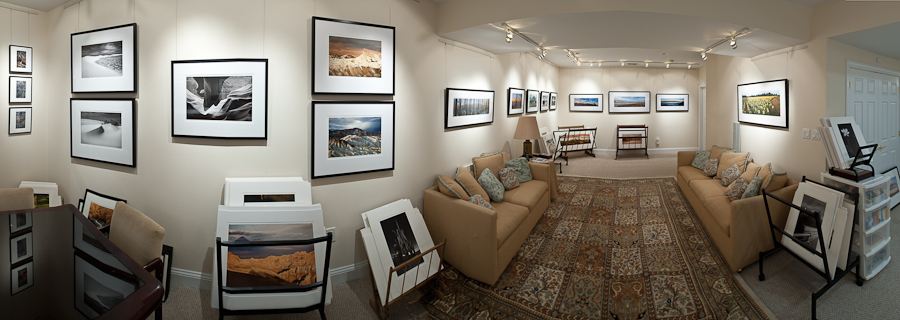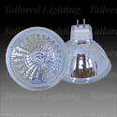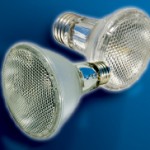
What do the following have in common:
Guggenheim Museum, NYC
Muse d’Orsay, Paris
National Gallery of Art, Washington, D.C.
Art Institute, Chicago
Carnegie Museum of Art, Pittsburgh
Sislen Fine Art Studio, Bethesda, Maryland
Answer: SoLux Lighting
Photographers know that the most important component of every photograph is “the light.” As much time as we spend trying to get the best light when we are making our images, often, too little time is spent considering how we light and display our finished work.
If you want your displayed artwork to look its absolute best, then you must carefully choose your lighting. In 2006, when I was planning my new studio and gallery, I had just visited John Paul Caponigro’s new gallery space and he had used SoLux bulbs in his light fixtures. When I saw the clarity and beauty of his displayed prints, I began researching SoLux bulbs, and when I outfitted my studio/gallery, I chose SoLux lighting.
I decided to use low voltage track lighting because I was also installing a hanging system and knew my photographs would not remain static. Track lighting gave me the flexibility to easily add, rearrange or remove lighting fixtures with a simple twist of the wrist, as well as to direct the light exactly where I wanted it.
Why SoLux?
As photographers, for our photographs to best “match” the colors and tonality range of our carefully processed images, we calibrate our monitors, use precise paper/printer/inkset profiles to make our prints, and soft proof so final adjustments can be made before printing. While we can’t control how the buyers of our work display our photographs, we can control how WE display our work by controlling the light under which it is shown. (I do know a photographer that gives every buyer of his work a SoLux bulb and explains that his work looks best when lighted by SoLux!)
You can read all of SoLux’s marketing and technical information on SoLux’s Website, but I have drunk the Kool-Aid and let me summarize why I only use their bulbs:
- they simulate clear, brilliant daylight better than any other lighting I have seen
- the colors of my color photographs seem to be totally natural and to “pop”
- the tonality range of my black and white photographs is brought out by these lights, with the blacks being true black, and the whites and all tonalities in between, being smooth and natural
- because of the UV and IR filtering in the bulbs, print longevity should be improved versus other lighting
- the CRI (Color Rendering Index), which is a measure of the ability to replicate daylight, is the highest of any bulb I have seen
For me, the bottom line, is that my photographs just look better when shown under SoLux lighting!
When I installed my lighting, I decided to buy the bulbs, track and lighting fixtures from Tailored Lighting, who invented SoLux and who runs the SoLux website referenced above. I was expecting the price of the MR16 halogen bulbs 
Having been indoctrinated that “proper” lighting for photographs was 5500k, I was quite surprised when Phil Bradfield, Tailored Lighting’s expert on SoLux bulbs, convinced me to use 3500k bulbs for display and 4700k bulbs for comparing my prints to my monitor. Phil was absolutely correct. You can read more about using Solux bulbs for photography at SoLux for Photography.
After many years of research and testing, in 2010 SoLux introduced PAR 20, Par 30 and PAR 38 bulbs.  These are also halogen bulbs, but in the more familiar PAR format that we normally see in “down lighting” fixtures which sometimes are called “can light fixtures.” The availability of these “standard screw-in” spot and flood bulbs means that you don’t have to install track lighting to get the advantages of SoLux bulbs. Tailored Lighting sells a number of extension arms and accessory items to help you direct the light to your artwork.
These are also halogen bulbs, but in the more familiar PAR format that we normally see in “down lighting” fixtures which sometimes are called “can light fixtures.” The availability of these “standard screw-in” spot and flood bulbs means that you don’t have to install track lighting to get the advantages of SoLux bulbs. Tailored Lighting sells a number of extension arms and accessory items to help you direct the light to your artwork.
Whether you’re displaying your artwork for potential customers, for friends and family, or even for your own pleasure, do yourself a favor and learn how important it is to use lighting that shows your work at its best. You won’t be sorry!
Tips for Track Lighting:
- To determine how far from the wall should the track be installed, for “normal” eye-height hanging, measure the distance from the center of the artwork to the ceiling. The “ideal” distance for the track lighting is .6 – .7 times that distance. In other words, if the center of your artwork is 43″, the the track should be installed from 26″ – 30″ from the wall.
- For other than eye-height hanging (over a mantle or artwork that is double or triple hung), you may need to experiment to achieve optimal light coverage.
- The ideal angle for the lighting fixture is approximately 30 degrees angle from the surface being illuminated, which is obviously dependent on how far the track is installed from the wall.
- Check with your electrician regarding how many lighting fixtures can be installed in a track. It depends on the 1)the amp rating of circuit breaker the track is connected to, 2)the amp amount that each bulb draws, 3)what else is connected to that circuit breaker.
- When turned on, halogen bulbs and fixtures get VERY hot. NEVER touch the fixture with your bare hands!
- If you don’t use SoLux’s fixtures, be absolutely certain that the fixtures’ specifications are adequate for these halogen bulbs.
- Carefully look at your studio/gallery setup and plan ahead whether all your track lighting will always be on or off at the same time. You will probably be well advised to have your electrician install multiple light switches to give you maximum flexibility. For example, I have a lighting track over my matting/framing table. That track is on a separate switch from other tracks.
Disclaimer: I have no association with Tailored Lighting or SoLux and have received nothing from them, other than an outstanding product and excellent advice for the last 5 years.


Used them in my studio for years. They are the best.
Alan – you convinced me to use Solux lighting a few years ago, and I really love it. Folks hanging two rows one might consider using 35 watt bulbs on the upper row and 50 watt bulbs on the lower row – this has worked well for me. I have 15 bulbs on one circuit that I wanted to be able to dim; this required installing a heavy duty (and relatively expensive) dimmer. Dimming Solux bulbs causes them shift to a redder color but it is still very pleasing at all dim levels.